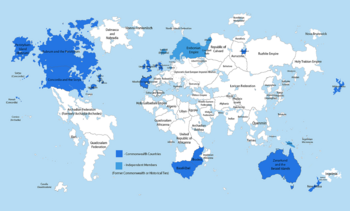Lucis Commonwealth of Nations
This article is incomplete because it is pending further input from participants, or it is a work-in-progress by one author. Please comment on this article's talk page to share your input, comments and questions. Note: To contribute to this article, you may need to seek help from the author(s) of this page. |
Lucis Commonwealth of Nations | |
|---|---|
|
Flag | |
 Map highlighting the member states of the Commonwealth of Nations. | |
| Headquarters | Marlborough House, Insomnia, United Kingdom |
| Official languages | English, Nihhonese, German |
| Type | Intergovernmental organization |
| Member states | |
| Leaders | |
• Head | King Noctis Lucis Caelum |
• Secretary-General | Tatsugorou Tatsuma |
• Chairperson-in-Office | Frederick Hanley |
| Establishment | |
• Statue of Herrenhausen | 9 October X868 |
• Insomnia Decoration | 28 April 1949 |
| Area | |
• Total | 29,958,050 km2 (11,566,870 sq mi) (1st) |
| Population | |
• 2013 estimate | 2.328 billion |
• Density | 75/km2 (194.2/sq mi) |
| GDP (PPP) | 2014 estimate |
• Total | $14.623 trillion (2nd) |
• Per capita | $6,222 (116th) |
| GDP (nominal) | 2014 estimate |
• Total | $10.450 trillion (2nd) |
• Per capita | $4,446 (132nd) |
The Lucis Commonwealth of Nations (Known as the Lucis Commonwealth or simply The Commonwealth) is an intergovernmental organization of 15 member states that were mostly territories of the Lucis Empire and some states were eligible due to historical ties, treaties and relations.
The Commonwealth dates back to the early 1900s and after the Second Lucis Civil War with the decolonisation of the Lucis Empire through increased self-governance of its territories. It was formally constituted by the Statute of Herrenhausen of X868 (1936), which established the member states as "free and equal". The symbol of this free association is King Noctis Lucis Caelum who is the Head of the Commonwealth. The King is also the monarch of 11 members of the Commonwealth, known as Commonwealth realms. The other members of the Commonwealth have different persons as head of state: 4 members are monarchies with a different monarch. (In the case of Tristain-la Fontaine, Queen Henrietta remains as sovereign but is a representative of King Noctis Lucis Caelum in Tristain after the union.)
In 1977, King Regis Lucis Caelum CXIII approved both the Erebonian Empire and the Holy Nation of Alteria into the Lucis Commonwealth, making the two nations a member of the Lucis Commonwealth since their independence from Great Lucis in 1920.
History
Membership
Criteria
Members
Erebonian Membership Dispute (1937-1976)
In 1937, The Erebonian Parliament expressed its interest in joining the Organization in order to seek safeguard of its interest from the Autocratic East Europan Imperial Alliance as well as reestablishing the high morality of relations with the UK and the rest of the Lucis Commonwealth. It was however rejected and Erebonia's eligibility was disputed for more than 30 years but the Erebonian Empire and the UK fought on the same side during the Second Europan War. It was then by an Act of Parliament in 1976 revised the eligibility and there, it stated:
That a country whose a "part" of its lands had been under Lucis Rule prior to the year 1936 is eligible unless a circumstance can cause it to be voided.
1/4th of the Erebonian Empire lands had been under Lucis Administration from 1791 to 1920, making the Erebonian Empire eligible. While Alteria's membership was approved in 1975; In 1976, The organization proclaimed the Erebonian Empire as its newest member before the two nations were approved by the King. This is the first time in history that an Empire whose lands were partly conquered by another Imperialist joins in the organization whose former colonial master is the head of the organization.
